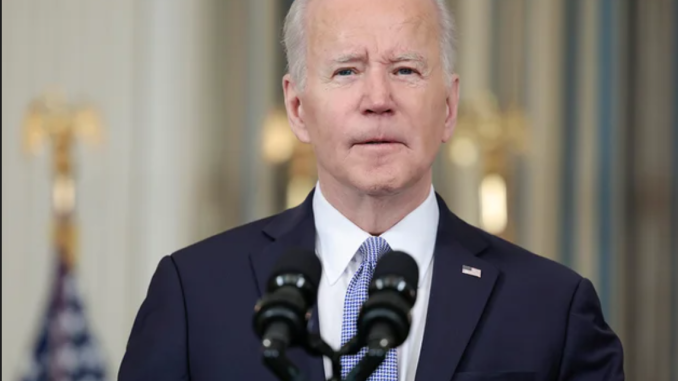
Biden and his top advisers know that the window to change the economic narrative through executive action is rapidly closing.
The professionals who track American attitudes toward the economy say they can see the trouble coming.
Angry voters slammed by higher prices and scarred by two years of fighting the pandemic are poised to punish Democrats in midterm elections, according to some of the leading experts in consumer sentiment and behavior.
And with inflation persisting and Russia’s war on Ukraine stoking uncertainty, there are indications that public sentiment is getting worse, not better, posing a growing threat to Democrats’ already slim chances of holding onto Congress, they say.
The widely watched University of Michigan consumer confidence survey recently touched its lowest level in almost 11 years. An Associated Press/NORC survey showed that almost 70 percent of Americans think the economy is in poor shape, and 81 percent of those in a poll released by CNBC see a recession coming this year. Gallup found the share of Americans citing inflation as the top issue is now at its highest level since the 1980s.
“The big run-up in gas and food and home prices has really caused great hardship for many households,” said Richard Curtin, a veteran economist who has run the University of Michigan consumer survey since 1976. “And the Biden administration made a critical error in saying it would be transient and people should just tough it out. It wasn’t transient. A lot of people couldn’t just tough it out. And it caused a big loss of confidence in [President Joe Biden’s] policies.”
Inside the West Wing, Biden and his top advisers know that the window to change the economic narrative through executive action is rapidly closing, according to a senior Biden aide and an outside adviser. The options, they say, mostly include whatever can be done to ease oil prices, the biggest drag on the party right now. But even that could have only limited impact.
Mark Zandi, the chief economist at Moody’s Analytics and lead author of a closely followed model that ties political outcomes to economic conditions, said this is among the toughest environments for the incumbent party that he’s ever seen, despite a booming job market.
Moody’s is working on its model for the 2022 midterms, and Zandi said that as of now it’s likely to show a very tough path for Democrats to hold either the House, where they have a razor-thin margin, and the Senate, which is split 50-50.
“Most Americans have never experienced high inflation like this, particularly on gas prices, and it has gotten everyone very upset,” he said. “Behavioral economics reveals that people hate inflation more than they love a low unemployment rate. And the pandemic still colors everything. People have been through the wringer.”
None of this is lost on Democratic aides and economists inside and outside the White House. One senior Biden aide, who declined to be identified by name because they were not authorized to speak publicly on the matter, said efforts to free up more oil and further ease supply chain bottlenecks would continue.
And the president will point to strong positives in the economy including continued strong job growth, a large number of available positions, higher wages and a jobless rate of just 3.6 percent, a pandemic low. Most of those numbers are far better than economists were predicting a year ago.
“There are still things we can do and arguments we can make, but frankly it would have been better had Vladimir Putin not invaded Ukraine,” the aide said. The White House did not immediately respond to requests for comment.
Inflation was rapidly rising long before the war suddenly sent energy and food prices spiking even more and injected new volatility into global markets that were previously celebrating the end to the worst of the pandemic. Still, other indicators were trending the administration’s way.
Austan Goolsbee, a University of Chicago professor who served as a top adviser to then-President Barack Obama, said the economy looks like it will be a headwind for Democrats. But he said some things could go right between now and Election Day in November.
“There are still some glimmers of light for the White House right now,” Goolsbee said. “Supply chain pressures really may ease up. And the virus, which was way worse than expected, has been the primary driver of everything. And if we are in fact going to get out from under the grip of the virus, that should reverse some of the sourness that is now in all the polling and consumer surveys.”
There is a lot to reverse, at least according to the latest survey conducted by the AP and the NORC Center for Public Affairs Research at the University of Chicago.
“With energy and consumer prices on the rise, 69 percent consider the national economy to be in poor condition,” Marjorie Connelly, a senior fellow in public affairs and media research at the NORC Center, said in a note. “Fifty-five percent say they don’t blame … Biden for high gasoline prices, but 65 percent disapprove of how he is handling the economy. Americans are more likely to think his policies have done more to hurt the national economy than to help it.”
The survey offered some reason for optimism for Democrats, given that a majority of Americans don’t blame Biden for the higher gas prices. The numbers also generally break down along partisan lines in most polling, with Republicans more likely to blame the president for economic problems. People also mostly still feel confident in their own personal finances even as they worry about other people and the national picture, the survey said. And they worry a lot.
“It’s just a tough road for Biden and Democrats to hoe right now,” said Curtin.
* story by Politico


